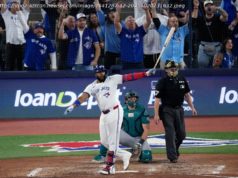The World Cup was one of the last hangers-on of old viewing habits but millennials are seriously starting to disrupt that, the Financial Times reports.
Ned Newell-Hanson, a 26-year-old Londoner, watches football obsessively but avoids paying for it. Some of his happiest moments are watching Chelsea games on his mobile, ideally on his balcony with a glass of wine but if necessary on a bus, hours after they have ended. (He goes to great lengths to avoid prematurely hearing the score.)
This scheduling allows him to have a normal life while still not missing a moment of his favorite team. He has registered his devices on various relatives’ and friends’ Sky and BT Sport accounts, so that he can see the games free. « I go through my PlayStation, so I can stream to my TV, » he says. « I never watch live television. »
He also spends about as much time playing football video games as watching real matches. The one big difference between him and fellow millennials, he says, is that they rarely immerse themselves in one match for 90 minutes: « A lot of my friends will be on their phones doing other stuff practically half the game. »
Mr. Newell-Hanson has just moved to New York, where he plans to watch the World Cup in bars. But his generation’s embrace of new forms of viewing is transforming humanity’s favorite TV event.
Digital disruption has already hit the entertainment, marketing and advertising industries hard. Music revenues, for instance, have plummeted in the past 20 years as streaming replaced CDs. More recently, streaming has revolutionized viewing, too: young Britons now watch more Netflix than all forms of BBC television combined.
Global TV viewing of sports peaked in 2012, according to the Futures Sport consultancy. But football’s World Cup has clung on as the last « appointment to view » — an occasion for people to turn on the TV. Now it too is finally being disrupted, though not destroyed. This summer’s tournament in Russia will probably attract more viewers than any previous World Cup, or indeed any other single event in human history. Even young people will watch it on television. Yet millennials in particular will also consume it in ways that were rare or non-existent during the previous tournament in 2014.
The TV set — the central device of the football economy these past 30 years — has a growing array of rivals. That is frightening for traditional broadcasters and sports-rights owners such as Fifa, the sport’s international governing body, but thrilling for the queue of new companies hoping to benefit.
The World Cup is on free-to-air TV in most countries, and what was once almost solely a European-Latin American event now saturates the planet. The cumulative global TV audience for this summer’s tournament will be 10.8bn, 14 per cent more than during the Brazil tournament in 2014, forecasts Kevin Alavy, global managing director of Futures Sport. He says: « Having Russia as host nation means that more matches will take place at more convenient times of day for European and Asian audiences than those played in Brazil. » Futures Sport’s estimates do not even include online streaming, which has become an increasingly common way to watch matches as viewing quality on smartphones has improved.
For many younger fans, the match may just be on one of the several screens they will monitor simultaneously, says Tom Thirlwall, chief executive of Copa90, a London-based online media company that focuses on fan culture. Especially for minor games or those played during work time, few millennials will follow every kick of the ball. « That is very much a declining habit: groups sitting in front of the TV in the lounge, » says Mr. Thirlwall. In the smartphone era, younger people seldom watch anything for more than a few minutes in a row. If a goal is scored in Russia, they will quickly find the clip somewhere, either on a legal site or a pirated one. They may not even know whether material is pirated.
Watching live matches will be just a fraction of millennials’ engagement with this World Cup. They will also banter about games with friends on social media, bet online and catch up with highlights from earlier games on YouTube, as well as liking videos made by friends who are in a stadium in Russia or some lively bar. Mr. Thirlwall forecasts: « The participation will be greater than ever. People will be constantly plugged into the stream of football content that will be coming out. »
Some of that content will be far removed from Russian football fields. Millennials will use the Fifa 2018 video game to recreate moments from real matches, or listen to music clips with a World Cup connection, or watch a Snapchat or Instagram video made by a player in his hotel room. Football videos on Instagram attracted 2.9bn views in the third quarter of 2017, up 917 per cent in two years, according to the video analytics company Tubular Labs. Other new forms of football-related viewing are also surging, such as watching competitive gaming or « crossbar challenges » (in which players compete to hit the goal’s crossbar).
The World Cup has always been about more than just the matches. In fact, many people love it despite the matches. Perhaps above all, the tournament is a global carnival of fans. What happens off the field, in the world’s bars and living rooms, can be more moving and funny and compelling than the frequently boring games themselves. Will Scougal of Snap, parent company of the messaging app Snapchat, sees a trend towards fans « putting themselves and their personalities at the heart of the way they experience the World Cup with their friends ». This summer, more than for any previous tournament, the world’s cameras will be turned away from the field.
Turning away from the field has earned Copa90 150m views a month. The company plans to send about 40 reporters to Russia, and deploy another 300 correspondents globally, but they will be telling fans’ stories rather than covering matches. Narrated videos will show fans from Tehran to Lagos living the tournament. « Telling stories outside the 90 minutes that make the 90 minutes matter more, » says Mr. Thirlwall.
In Copa90’s headquarters in London’s Farringdon district there is a little studio kitted out like a hipster bar. Mr. Thirlwall says it cost £2,500 (US: $3,343.00) to set up — a number that made a visiting traditional broadcaster gulp. From here, Copa90 will make programs that aim to appeal to millennial sensibilities in a way the BBC does not.
For this World Cup, many millennials will tune into their national TV broadcasters to watch matches, but will skip the punditry shows in which former players in suits spout platitudes. « TV produces a product for old people, » says Matt Boffey of brand technology agency Great State. Mr Newell-Hanson agrees: « All my friends make the same comment: ‘We don’t understand why there are so many ex-footballers making banal comments.' » He makes an exception for Gary Neville, but mostly gets his match analysis from podcasts instead. Other millennials will go to fan channels for particular teams or players.
Any company that attracts pre-match, half-time and post-match viewers can rake in advertising dollars. The 2014 World Cup boosted global advertising spend by $1.5bn, estimated the ZenithOptimedia Group of media agencies.
Broadcasters know they need to change with the times. Some have partnered with new actors in the football economy. Telemundo in North America, for instance, has tied up with Copa90. Similarly, the BBC is treating social media not as competitors but as new delivery mechanisms to reach young viewers. This World Cup, the BBC will put match clips on Snapchat and Twitter, as well as stream games online and cover the fans’ carnival, although the corporation’s biggest total audience for the tournament will still be on TV.
Fifa, too, will need to start adapting, as the match footage that is its one lucrative asset becomes less central for viewers. Football’s global authority could start selling TV rights to teams’ training sessions, or to official fanzones in Russia where supporters without match tickets will watch games on big screens in a party-like atmosphere, or organize its own crossbar challenges, suggests one venture capitalist who tracks viewing habits.
This World Cup will offer new opportunities to national teams and players. Even the 2014 tournament generated more than 2bn interactions (likes, comments or shares) from 350m Facebook users, says Jerry Newman, Facebook’s head of sports partnerships in Europe, the Middle East and Africa.






